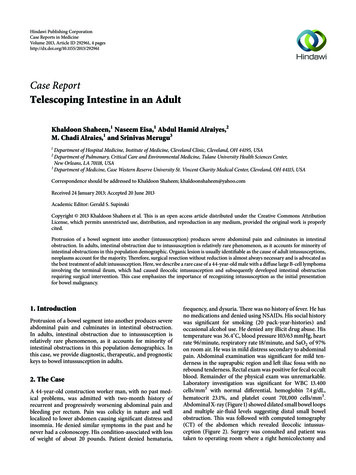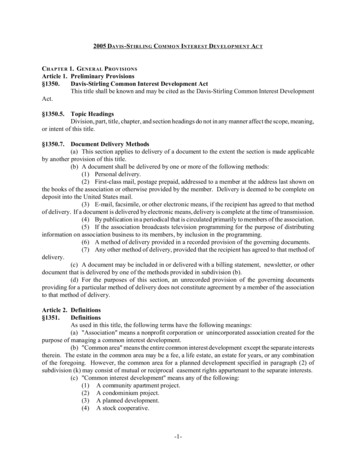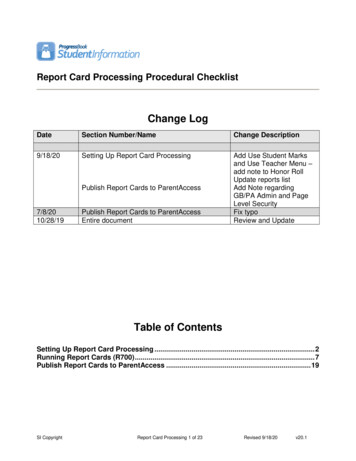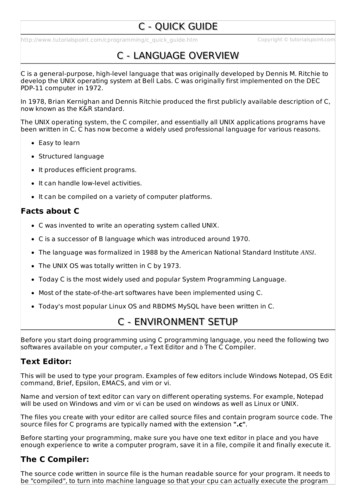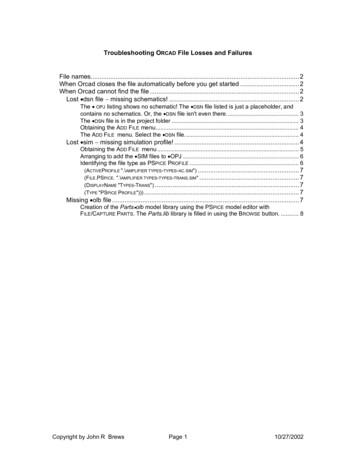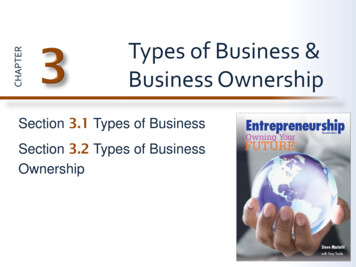
Transcription
CHAPTERTypes of Business &Business OwnershipSection 3.1 Types of BusinessSection 3.2 Types of BusinessOwnership
SECTIONTypes of BusinessOBJECTIVES Identify the four main types of businessExamine trends in business startups in recent decadesExplore growth expectations for businessSection 3.1: Types of Business2
Types of BusinessA manufacturing business (manufacturer) converts materialsinto goods suitable for use and then sells those goods to others. A wholesaling business (wholesaler) buys goods inlarge quantities, typically from manufacturers, andresells them in smaller batches to retailers.A retailing business (retailer) buys goods, often fromwholesalers, and resells them directly to consumers,who are the end buyers.A service business provides services to customers fora fee.Section 3.1: Types of Business3
Trends in Business StartupsOver the past fifty years, the business make-up of the UnitedStates has changed significantly. In the 1950s, the country’s dominant industry wasmanufacturing.During the 1950s and 1960s, America experienced aboom in franchising.By 1970, service, wholesale, and retail businessesaccounted for the majority of America’s economicproduction.The vast majority of businesses started in the 2000shave been service and trade businesses.Section 3.1: Types of Business4
Businesses of the FutureThe U.S. Department of Labor makes predictions onwhich industries will likely experience the largestgrowth in number of employees in the following decadeusing the The North American Industry ClassificationSystem (NAICS). The top ten companies have one thing in common—they provide some type of service. This demonstratesthat service businesses are expected to dominate theU.S. economy through 2020. Section 3.1: Types of Business5
SECTIONTypes of BusinessOwnershipOBJECTIVES Define liabilityExamine sole proprietorshipsLearn about partnershipsExamine corporationsUnderstand cooperativesSection 3.2: Types of Business Ownership6
Liability of Business OwnersOwner’s liability is the legal obligation of a business owner to usepersonal money and possessions to pay the debts of thebusiness. Unlimited liability means that a business owner canbe legally forced to use personal money andpossessions to pay the debts of the business.Limited liability means that a business owner cannotbe legally forced to use personal money andpossessions to pay business debt.Section 3.2: Types of Business Ownership7
Sole ProprietorshipsA sole proprietorship is a legally defined type of businessownership in which a single individual owns the business,collects all profit from it, and has unlimited liability for its debt.The sole proprietorship is the simplest and leastexpensive option for business ownership. Because the owner and the business are one and thesame, business income and costs are reported on theowner’s personal income tax return. In a sole proprietorship, only one individual isresponsible for the business. The sole proprietor has unlimited liability for anybusiness debts. Section 3.2: Types of Business Ownership8
PartnershipsA partnership is a legally defined type of business organizationin which at least two individuals share the management, profit,and liability. In a general partnership, all partners have unlimitedliability.A limited partnership is structured so that at least onepartner (the general partner) has limited liability for thedebts of the business.General partnerships rely on the entrepreneurial skillsand financial backing of at least two individuals.Because general partners have unlimited liability, theyrisk losing personal money and possessions to paybusiness debts.Section 3.2: Types of Business Ownership9
CorporationsA corporation is a legally defined type of business ownership inwhich the business is considered a type of “person” (or “entity”)under the law, and limited liability is granted to the businessowner(s). The owners of a corporation are called its shareholdersor stockholders.A share of stock is a unit of ownership in a corporation.Each share may earn its owner a dividend, which is aportion of the corporation’s profit.Shareholders have a limited liability. They risk only themoney they invested in the corporation.Section 3.2: Types of Business Ownership10
Types of Corporations Most corporations are C corporations, which are taxedas an entity by the federal government.A subchapter S corporation differs from a C corporationin how it is taxed. It is not taxed as an entity, rather itsincome or loss is applied to each shareholder andappears on their tax returns.A limited liability company is a legally defined type ofbusiness ownership similar to a C corporation, but withsimpler operating requirements and tax procedures andgreater liability protection for the business owners.A nonprofit corporation is a legally defined type ofbusiness ownership in which the company operates not toprovide profit for its shareholders but to serve the good ofsociety.Section 3.2: Types of Business Ownership11
CooperativesA cooperative is a business owned, controlled, andoperated for the mutual benefit of its members—peoplewho use its services, buy its goods, or are employed byit. In the U.S., cooperatives are not as common as othertypes of businesses and are often organized ascorporations. Cooperatives often share their earnings with themembership as dividends. Section 3.2: Types of Business Ownership12
A corporationis a legally defined type of business ownership in which the business is considered a type of "person" (or "entity") under the law, and limited liability is granted to the business owner(s). The owners of a corporation are called its shareholders or stockholders. A share of stock is a unit of ownership in a corporation.
